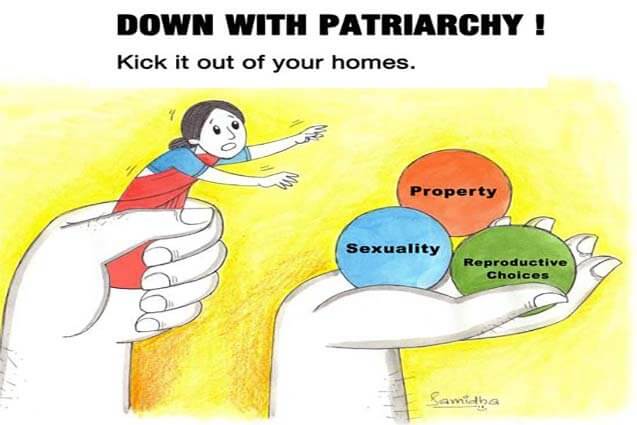“I would get married and try my best to be best daughter-in-law of the world,” says Bimla proudly during an informal discussion about our after-school plans. Surprised to hear this, I asked don’t you aspire to study further and to have a career of your own? “What would you do with your studies when you are destined to serve your husband and in-laws after marriage,” she replied.
There has always been a question of how culture has shaped society, whether on the basis of community separation or social institutions like that of family, caste, creed, class, gender and race. The statement mentioned above clearly illustrates that young women still think that their only purpose in life is to serve a man and that creates a perfect environment to nurture patriarchy.
More so than men, women themselves forge this age old idea in their minds, because they have been conditioned that way through lots of aspects of culture and history. Matriarchal and Matrilineal families are hardly heard of in anywhere except for concepts in syllabuses about familial structure. Some anomalies are perhaps seen in remote areas of the North eastern states like Mizoram and Meghalaya.
To be studying in a school that consisted of a variety of different cultures, I know from personal experience, how families outside the glitz and concrete live and function as communities. Though affluent in financial and often political contexts, the treatment of women in their families follows the same traditional patriarchal pattern of men supremacy.
Studying in the Humanities section, I was surrounded by students of all sorts, as Arts is still deemed the inferior of the academic lot, I was thrown in with a diaspora of cultural accumulation. When asked as to what his plans were after school, a boy belonging to an affluent family answered “I’ll take up my dad’s business and then get married to a girl of their choosing”. When asked how she would be treated and what would her freedom in the family be if she decided to have an independent career, he started laughing. Asking if I made a joke, he said, “Didn’t you though?” Women are not expected to come out of the domestic bubble and the thought itself is literally “laughable” to the boy in question.
The concept of divorce again is seen as nonexistent. “We don’t believe in divorces” said the boy, as if a device in his head went off at just the right time protecting the values and beliefs of his community. Hearing these scenarios in the 21st century perhaps defies the whole purpose of modern education and progress. The goal of gender equality seems far off when taking a look towards these communities. Such scenarios take place in real life and often make us question our cultural upbringing and learning.
One aspect that has been common throughout the transition of these institutions is the standing of women. Patriarchy, debated time and again, has been the source of discussion and often entertainment in the upper and middle income groups as they can afford to sit down and talk about it like it’s an easily solvable issue and not a cultural construct going on for what seems like millennia.
The lower-income strata on the other hand have given this practice many names, fate, destiny and moreover karma. The treatment of women though has had more of a similarity that is often glossed over by the differences in income and social status. Seen vividly in states all over India, women are treated as nothing but pawns for money and pleasure. The after effects of these beliefs such as female foeticide, domestic violence, rape and various others that have not only led to the suppression of female opinion but has also scarred the existence of the female sex. In a written reply in Lok Sabha, Women and Child Development Ministry Maneka Gandhi said a total of 24,771 dowry deaths have been reported in the country from 2012-14 with maximum of them occurring in Uttar Pradesh with 7,048 deaths. If we look at the NCRB data, the country has recorded 3.48 lakh cases of cruelty against women by the husband or his relatives, and West Bengal tops the chart with 61,259 such cases in past three years. According to a recent ActionAid survey, over 4 in 10 women in India face sexual harassment before the age of 19 again pointing out the transparent disregard of a woman’s safety in India.
But pinpointing it to certain class or community would be wrong, this ideology of weakness in women has been carved immaculately and often so effortlessly that most have forgotten to question its existence. The beauty of a system is an execution that makes the system seems normal. Something that patriarchy has achieved. Normalisation of this particular tendency has led to women shutting their mouths on matters such as marital rape and domestic torture.
Through the gaps of generations, there have been revelations but these are muddled with controversies, some on the definition of feminism and equal rights, others on the position of women in the overall social hierarchy and many others. There has been significant progress throughout the decade. Campaigns the #HeForShe, One Billion Rising, 16 Days of Activism on Violence Against Women, ActionAid India initiated Beti Zindabad campaign and the Beti Bachao Beti Padhao Abhiyan by Ministry of women are few initiatives that have been striving for gender parity and participating in trial to stash this ideology away.
Our race to achieve the “modernist agenda” has perhaps let a little bit of social welfare seep in, but we are a long way from achieving the real deal.
Disclaimer: The author is an intern with ActionAid India and the views expressed in this article are of her own.
 Author: Akanksha Bose
Author: Akanksha Bose




